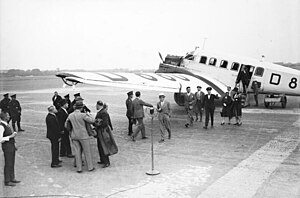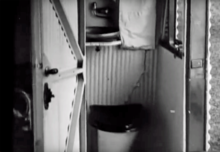Junkers G 24
| Junkers G 24 | |
|---|---|

|
|
| Type: | Airliner |
| Design country: | |
| Manufacturer: | |
| First flight: |
1925 |
| Production time: |
1925-1929 |


The Junkers G 24 was a three-engine, as low-wing aircraft out deliberate airliner German Junkers aircraft factory from the 1920s. It offered space for nine passengers and two crew members.
history
In 1923, Hugo Junkers applied to the Allied Monitoring Commission responsible for German aircraft construction for the construction of a three-engine airliner. At the instigation of the commission, the design was rescheduled for a weaker drive and implemented as the Junkers G 23 from 1924 .
The first G 24 from 1925 were newly motorized versions of the G 23 built in Dessau . In order to circumvent the restrictions of the Versailles Treaty in force in Germany , the aircraft were flown to Sweden and converted to more powerful engines by AB Flygindustri . In the same year Junkers went over to only delivering the components of a revised version to Sweden and carrying out the final assembly there.
From May 1926 the restrictions ceased and Junkers relocated the final assembly back to Germany. This third series again showed small improvements.
Between 1925 and 1929 at least 72 aircraft were sold, including 26 to Lufthansa , which served the Cologne - Paris and Berlin - Königsberg routes with them.
construction
The G 24 was an all-metal aircraft designed as a low-wing aircraft . Except for the engine, the first series was identical to the G 23, which was converted into it. The second series, which was completely assembled in Sweden, was slightly larger with a wingspan of 29.37 m and a length of 15.15 m. Another enlargement took place in the third series assembled in Germany.
Over time, the G 24 got more and more powerful engines. The G 24a version usually had three Junkers L 2 in- line engines and, as an exception, a Junkers L 5 as a mid-engine. Two aircraft delivered to Italy received an Isotta Fraschini with 221 kW as a mid-engine. The G 24ge had three Junkers L 5, while the G 24gu received two Junkers L 5 and a Junkers L 5 G as a mid-engine.
The Junkers Type G 24 W was equipped with floats, which enabled it to be used as a seaplane .
use
With the three-engine Junkers G24, Lufthansa opened the world's first scheduled flight service with passengers at night on May 1, 1926 on the Berlin – Königsberg route.
Several payload records were set with the G 24. Fritz Horn set a combined record on April 24, 1927 . With a payload of 1000 kg, he flew 2020 km at an average speed of 140 km / h in 14 h 23 min.
Wilhelm Zimmermann achieved an average speed of 209.115 km / h on a 500 km measurement route with a 1000 kg payload.
This type became known for the 20,000 km flight route of two Lufthansa planes from Berlin to Beijing . The flight took off on July 24, 1926. On September 26, 1926, the two planes landed safely in Berlin again.
This type has also been used in Switzerland , Turkey , Spain , Italy , Brazil , Austria , Greece , Finland and Afghanistan .
The Soviet Union won in 1926 and 1927 from the Junkers subsidiary in Sweden 23 G 24, in the Junkers branch in Fili near Moscow to jug-1 -Bombenflugzeugen were rebuilt. They received five 7.62 mm machine guns and could carry 500 kg bombs. Some have also been converted to swimmers or skis.
Technical specifications
| Parameter | Data (1st series, wheel version) | Data (1st series, float version) | Data (2nd series) | Data (3rd series, wheel version) | Data (3rd series, float version) |
|---|---|---|---|---|---|
| crew | 2 + 1 cabin attendant | ||||
| Passengers | 9 | ||||
| length | 15.23 m | 15.60 m | 15.15 m | 15.70 m | 16.1 m |
| span | 28.50 m | 29.37 m | 29.90 m | ||
| height | 5.40 m | 6.00 m | 4.20 m | 4.15 m | 5.8 m |
| Wing area | 89.00 m² | 97.80 m² | |||
| Empty mass | 3600 kg | 3800 kg | 4192 kg | 4794 kg | |
| Payload | 2400 kg | 2200 kg | 2308 kg | 1706 kg | |
| Takeoff mass | 6000 kg | 6500 kg | |||
| Wing loading | 67.00 kg / m² | 66.00 kg / m² | |||
| Power load | 10.03-8.7 kg / hp | 7.3 kg / hp | |||
| Engines | water-cooled six - cylinder four-stroke in - line engines | ||||
| Number / type | three Junkers L 2 | one Junkers L 5 , two Junkers L 2 | three Junkers L 5 | ||
| Nominal power on the ground | 230 PS (169 kW) each | 310 PS (228 kW), each 230 PS (169 kW) | 310 PS (228 kW) each | ||
| Fuel volume | 1300 l | 1290 l | |||
| Fuel consumption at cruising speed |
approx. 120 kg / h | 160 kg / h | |||
| Top speed | 175 km / h near the ground 160 km / h at an altitude of 2000 m |
165 km / h near the ground 150 km / h at 2000 m altitude |
195 km / h | 197 km / h | 185–191 km / h near the ground |
| Cruising speed | 150 km / h | 145 km / h | 170 km / h | 162 km / h | 156 km / h |
| Landing speed | 90-105 km / h | 103 km / h | |||
| Climb performance | 2.80 m / s | ||||
| Rise time | 8 min at 1000 m altitude 20 min at 2000 m altitude 40 min at 3000 m altitude |
10 min at 1000 m altitude 28 min at 2000 m altitude |
6.5–7 min at 1000 m altitude 14-17.5 min at 2000 m altitude |
6.8–8.5 min at 1000 m altitude 16–20 min at 2000 m altitude |
|
| Summit height | 3800 m | 3400 m | 4700 m | 4455-4950 m | 4095-4550 m |
| Range | 1300 km | ||||
| Flight duration | 9 h | ||||
| Takeoff route | 220 m with a mass of 6000 kg | ||||
| Landing route | 200 m at 6000 kg mass | ||||
See also
literature
- Wolfgang Wagner: Hugo Junkers. Aviation pioneer - his aircraft . In: German aviation . tape 24 . Bernard & Graefe, Munich 1996, ISBN 3-7637-6112-8 .
- Günter Schmitt: Junkers. Pictorial atlas of all aircraft types . Motorbuch, Stuttgart 1990, ISBN 3-613-01339-8 .
- Günter Schmitt: Junkers and his planes . Transpress, Berlin 1986, ISBN 3-344-00192-2 .
Web links
Individual evidence
- ↑ Development of aviation and aircraft. ( Memento from May 31, 2008 in the Internet Archive )
- ^ Wolfgang Wagner: Hugo Junkers. Aviation pioneer - his aircraft. (= German aviation. Vol. 24). Bernard & Graefe, Munich et al. 1996, ISBN 3-7637-6112-8 , p. 232.
- ^ Karl-Dieter Seifert: The German air traffic 1926-1945. On the way to world traffic. (= German aviation. Vol. 28). Bernard and Graefe, Munich et al. 1999, ISBN 3-7637-6118-7 , p. 376.
- ^ Günter Schmitt: Junkers and his planes. transpress, Berlin 1986, ISBN 3-344-00065-9 , pp. 103, 122.
- ↑ K. Grasmann (Ed.): Airplane type tables. DMZ 1925-1927 . 1977 (facsimile reprint of Deutsche Motor-Zeitschrift 11/1925).
- ↑ Grasmann, issue 12/1925
- ↑ a b Grasmann, issue 8/1927


